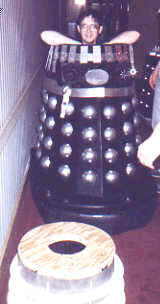|
|
Making Fred was like
moonlighting at a second job. I would come home from work, eat dinner,
then go down to the folks' basement to work for a few hours. Sometimes,
I would get really tired of the amount of work involved or get
discouraged by setbacks. The one thing that kept me motivated was
thining about the
looks of amazement I would get from St. Louis fans when a
"real-life" Dalek made an appearance.
If you're thinking of building a Dalek, based on what you'll see here, be sure you realize how much work is involved. I am by no means saying the way I built mine is the right or only way. I was using what few skills I had in the way of working with wood, sheet metal and so on. |
| Except for the few
good photo references and books I could find on Daleks, I pretty much
had to figure out how to make "Fred" out of the materials I
could most easily handle. Perhaps the most valuable information I can hope
you might take away from this is to examine my decisions, see where you
might be able to improve upon my methods, and avoid some of the mistakes
I made.
By the way, if it really makes any difference, I believe all rights and images pertaining to the Daleks are the intellectual property of the estate of the late Terry Nation, and the BBC. No intention has been made here to infringe upon those rights. This "how I did it" is merely one individual's attempt to pay homage to these creations, and there is no attempt to gain monetarily from this document. |
|


